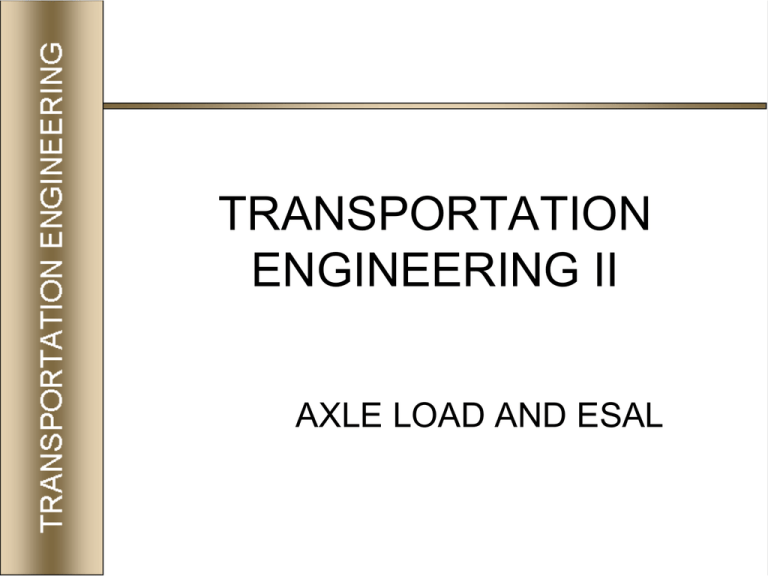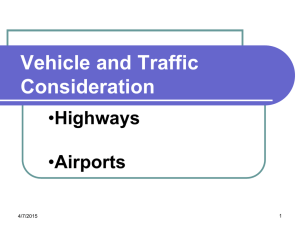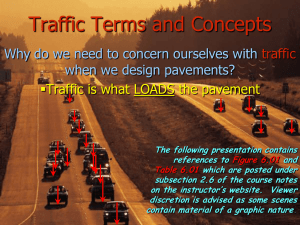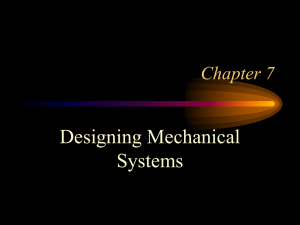File
advertisement

TRANSPORTATION ENGINEERING II AXLE LOAD AND ESAL AXLE LOADS • One of the primary functions of a pavement is its load distribution. Therefore, in order to adequately design a pavement something must be known about the expected loads it will carry during its design life. Loads, the vehicle forces exerted on the pavement (e.g., by trucks, heavy machinery, airplanes), can be characterized by the following parameters: – – – – – Tire loads Axle and tire configurations Repetition of loads Distribution of traffic across the pavement Vehicle speed • Damage caused to the pavements increases sharply with the axle loading. Vehicle loads of private cars and vans contributes very little to structural deterioration. For the purpose of pavement thickness design, only commercial traffic is considered. STANDARD AXLE LOAD • Different tests were performed to calculate the thickness of pavement, in relation to the no. of vehicles passing over various portions of roads. Statistical analysis of the data collected showed that relative damaging effect of an axle was approximately proportional to the fourth power of the load which it carries, irrespective of the type or thickness of the pavement. • An axle carrying a load of 18,000 lbs (8160 kg) was arbitrarily defined in the AASHO road test as a Standard Axle, with a damaging effect of unity. • The damaging effects of lighter and heavier axles were expressed as equivalence factors as shown in Table. The equivalence factor of .0002 for the 910-kg axle load means that 5000 a passes of such an axle would do the same damaging effect as one pass of standard axle. DAMAGING EFFECT OF DIFFERENT AXLE LOADS (AASHO ROAD TEST) AXLE LOAD KG LBS AXLE LOAD EQUIVALENCE FACTOR KG LBS EQUIVALENCE FACTOR 910 2000 0.0002 9980 22000 2.3 1810 4000 0.0025 10890 24000 3.2 2720 6000 0.01 11790 26000 4.4 3630 8000 0.03 12700 28000 5.8 4540 10000 0.09 13610 30000 7.6 5440 12000 0.19 14520 32000 9.7 6350 14000 0.35 15420 34000 12.1 7260 16000 0.61 16320 36000 15 8160 18000 1* 17230 38000 18.6 9070 20000 1.5 18140 40000 22.8 *Standard axle EQUIVALENT STANDARD AXLE LOAD • This approach converts wheel loads of various magnitudes and repetitions ("mixed traffic") to an equivalent number of "standard" or "equivalent" loads based on the amount of damage they do to the pavement. The commonly used standard load is the 18,000 lb. Equivalent Single Axle load. Using the ESAL method, all loads (including multiaxle loads) are converted to an equivalent number of 18,000 lb. single axle loads, which is then used for design. A "load equivalency factor" represents the equivalent number of ESAL’s for the given weight-axle combination. Generalized Fourth Power Law • A rule-of-thumb, the damage caused by a particular load is roughly related to the load by a power of four (for reasonably strong pavement surfaces). For example, • A 18,000 lb (80 kN) single axle, LEF =1.0 • A 30,000 lb (133 kN) single axle, LEF = 7.6 • Comparing the two, the ratio is: 7.6/1.0 = 7.6 Using the fourth power rule-of-thumb: Thus, the two estimates are approximately equal Traffic Loads Characterization Pavement Thickness Design Are Developed To Account For The Entire Spectrum Of Traffic Loads Cars Pickups Buses Trucks Trailers 13.6 Tons Failure = 10,000 Repetitions 11.3 Tons Failure = 100,000 Repetitions 4.5 Tons Failure = 1,000,000 Repetitions 2.3 Tons 13.6 Tons 4.5 Tons Failure = 10,000,000 Repetitions Failure = Repetitions ? 11.3 Tons 2.3 Tons RELATIVE DAMAGE CONCEPT Equivalent Standard 18000 - Ibs ESAL (8.2 tons) Damage per Pass = 1 Axle Load • Axle loads bigger than 8.2 tons cause damage greater than one per pass • Axle loads smaller than 8.2 tons cause damage less than one per pass • Load Equivalency Factor (L.E.F) = (? Tons/8.2 tons)4 Consider two single axles A and B where: A-Axle = 16.4 tons Damage caused per pass by A -Axle = (16.4/8.2)4 = 16 This means that A-Axle causes same amount of damage per pass as caused by 16 passes of standard 8.2 tons axle i.e, = 16.4 Tons Axle 8.2 Tons Axle Consider two single axles A and B where: B-Axle = 4.1 tons Damage caused per pass by B-Axle = (4.1/8.2)4 = 0.0625 This means that B-Axle causes only 0.0625 times damage per pass as caused by 1 pass of standard 8.2 tons axle. In other works, 16 passes (1/0.625) of B-Axle cause same amount of damage as caused by 1 pass of standard 8.2 tons axle i.e., = 4.1 Tons Axle 8.2 Tons Axle DAMAGE PER PASS 80 70 60 50 40 30 20 10 0 1.0 1.1 2.3 3.3 4.7 6.5 8.7 11.5 14.9 18.9 23.8 29.5 36.3 44.1 53.1 63.4 75.2 AXLE LOAD & RELATIVE DAMAGE 8 9 10 11 12 13 14 15 16 17 18 19 20 21 22 23 24 SINGLE AXLE LOAD (Tons)







